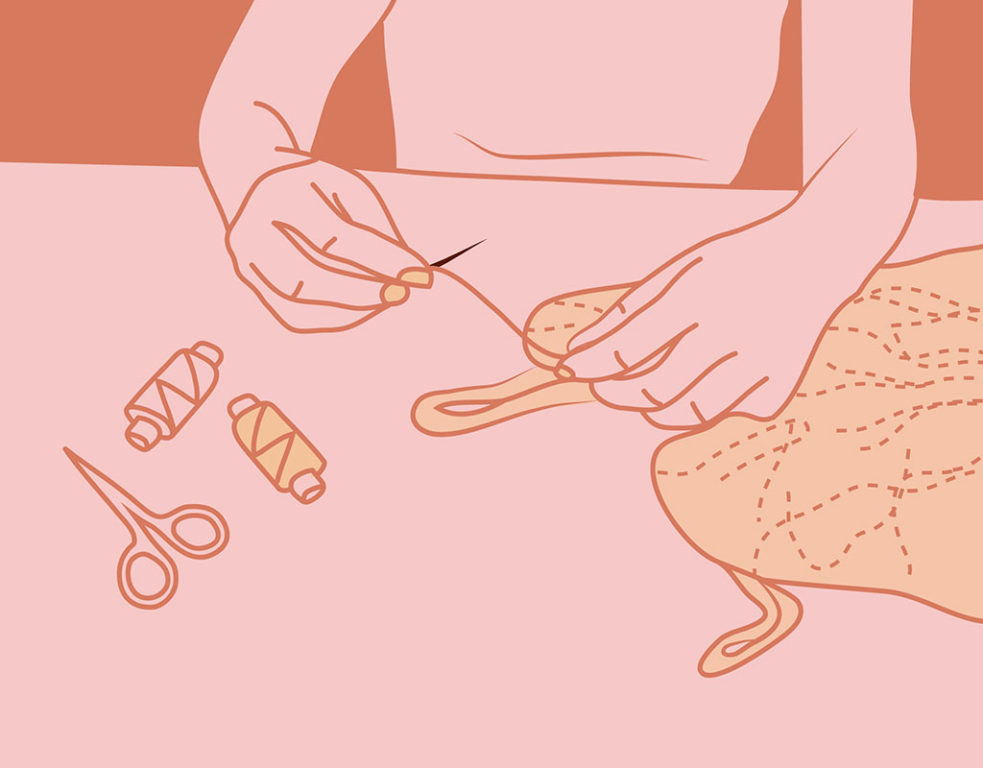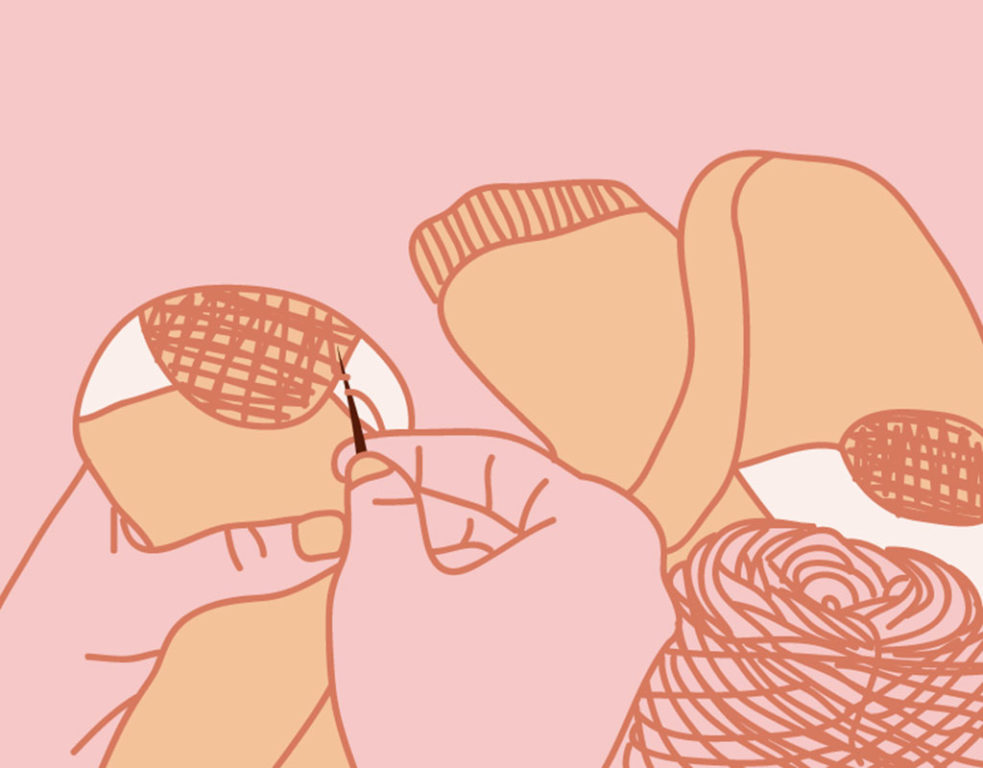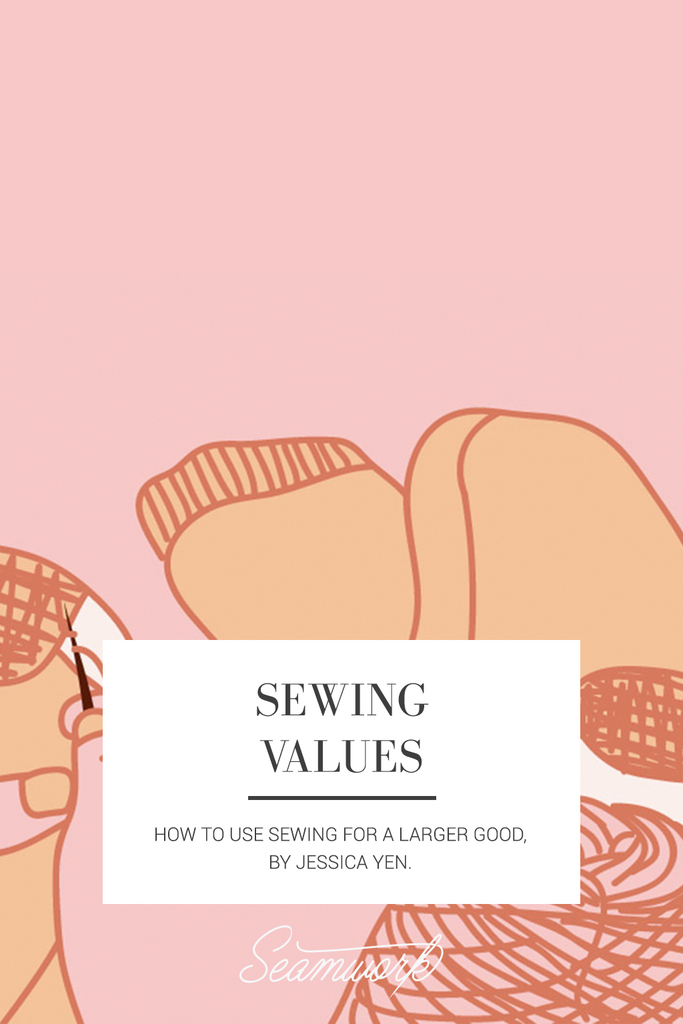Many sewists constantly seek ways to align their hobby with their values. This can include creating clothing that’s made to last, reducing fabric waste, sourcing ethically produced, organic, naturally dyed, local, or secondhand fabrics, and other approaches.
As I turn the corner on ten years of garment sewing, I’ve started to explore new ways to bring together sewing and values. In particular, I’ve been curious about expanding my realm of influence beyond personal choice, to touch other lives or even social movements. Although I expect this will be a lifelong endeavor, I wanted to share some early learnings in hopes of sparking a broader dialogue with the sewing community about sewing values—what we do, why we do it, and how we might use sewing for a larger good.
Mending for Others
I first tiptoed into this arena by mending jeans for my partner and his friends. Most are cyclists, which means their jeans prematurely wear out where saddle meets inner thigh. Therefore this targeted mend has salvaged many pairs of otherwise unusable jeans. Most of them bicycle to decrease their environmental footprint, which means they are particularly open to a clothing project that does the same. I can usually mend a pair in an afternoon; this short time commitment has been perfect for an initial foray into a new approach to sewing. Much to my surprise, I’ve found I enjoy mending jeans. It’s like a tactile color puzzle, and the reconstruction process creates a series of endorphin hits as each new section comes back to life. I’ve even occasionally been able to swap a bicycle tune-up in exchange for mending a pair or two of jeans.
I know the specifics of this approach won’t suit everyone, but I believe the lessons are useful nonetheless. Find people who will be receptive; start with a small time commitment; choose a project that will teach you new skills, expose you to new fabrics, introduce you to new techniques.

Auctioning Services at Fundraisers
This fall I donated a voucher for two pairs of customized panties to a silent auction whose proceeds went to defeating a local ballot initiative. At first I saw the voucher as a way to support an event I was unable to attend, but once I learned that my item had raised more money than I would have been able to donate personally, I realized sewing could help amplify my impact on causes I care about. It’s fun—a different way to contribute, and can be used for a wide range of causes.
We spend so much time immersed in our hobby that we can forget how much our skills are worth to others. The ability to wear clothing made from natural or organic materials, or luxury fabrics like stretch silk, can be a novelty for the non-sewist, and one they are happy to indulge in if doing so simultaneously benefits an issue that’s important to them.
Depending on the audience, panties may not be the most appropriate item to offer, but sewing is so versatile that you can easily identify a project (or projects!) that match your skill level and time. You might decide to participate in a certain number of events per year, or identify one or two organizations you most believe in, one cause you’re most passionate about, etc. Introducing the power of handmade to an entirely new audience, while also making a difference? Win-win.
We spend so much time immersed in our hobby that we can forget how much our skills are worth to others.

Teaching Visible Mending
Earlier this year I taught a workshop on visible mending at a local arts festival. For two hours, 14 participants stitched, embellished, patched, mended, and created the most beautifully unique pants, shirts, bags, sweaters, and socks I have seen. Each table was a riot of color. One woman even stitched straight onto the shirt she was wearing! Some participants were familiar with hand-sewing but had never thought to visibly mend their clothing; others learned to thread a needle for the very first time.
Over and over, I heard participants marvel at how much fun they were having, how relaxing it was to stitch and chat with others at their table, and, most importantly, how they now saw many more opportunities to rescue clothing and tote bags from their “to donate” pile. Two ladies even sat outside our classroom after the workshop ended, where they continued chatting and stitching.
In seeking to make a difference in the world, teaching is one way to amplify our impact by empowering others with skills and knowledge. I also found it powerful to combine several values within one teaching session. In my case, I first identified a cause, namely decreasing unnecessary consumption by extending the life of existing items. Then I sought to structure the event to foster several aspects of crafting I find important, like building a sense of community and encouraging creativity. Participants sat in small groups, and we paused regularly to share projects, swap ideas, and teach new stitches. This approach could also be extended to a particular community or group of people you would like to reach, like teaching refugee women to sew or a cancer (caregiver) support group to knit.
Although I don’t plan to dedicate all my sewing time to projects like these, they have been a fun way to spice up my project roster. Just as quick-and-easy projects serve as palette cleansers between complex projects, sewing projects that align with my values have been a fun and rewarding way to change up my sewing rhythm. Sewing has already provided innumerable opportunities for growth and learning in my life, and aligning handcrafts with values feels like a natural evolution that has already begun opening new venues for continued exploration.
More Sewing Values
Jessica has written several other Seamwork articles about slow sewing and sustainability. You can find them in the Seamwork archives here.
-
Breathing Easy: The science behind the relaxing properties of sewing, from issue no. 16 of Seamwork. -
Zero-waste Fit: How to decrease waste in the fitting process, from issue no. 26 of Seamwork. -
The Neglected R.: Let rituals transform your year, from issue no. 13 of Seamwork. -
Scraptastic Lingerie: Make the most of your scraps, from issue no. 14 of Seamwork. -
Inspiring Change: Spreading the word about slow fashion, from issue no. 12 of Seamwork.


